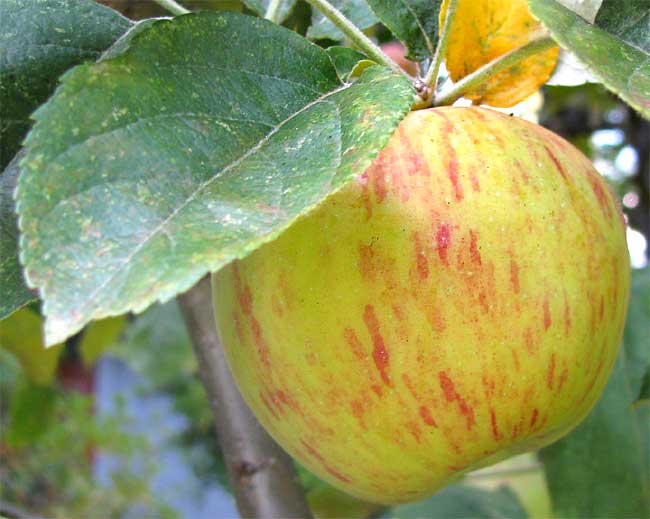Excerpts from Jim Conrad's
Naturalist Newsletter

from the the August 30, 2009 Newsletter, issued from the Siskiyou Mountains west of Grants Pass, Oregon:
GRAVENSTEIN APPLES
For the last couple of weeks I've been in pig heaven, for in the orchard apples have been falling and I've been picking them up and each afternoon making solar-apple-cornbread. Into about a cup of mixed cornmeal and wheat flour -- both ground from grain with Anita's little electric mill -- and enough water to make it pasty, I snip about five apples. The resulting mix is about 4/5ths apple, the batter basically just holding things together. This I plop into an oiled skillet, put it into my solar cooker, and within an hour the aroma of cooking apples drifts all over the place. While it's baking I just love sitting next to the cooker reading, absorbing the odor into my soul.
The apples are distinctive, being greenish yellow with vertically aligned short, narrow, reddish blotches. You can see one hanging on a tree now above.
Anita told me that these are Gravenstein Apples. I read that Gravensteins are generally considered one of the best all-around apples, with a sweet, tart flavor and especially good for baking and cooking. I just hit it lucky having them available during a long train of sunny afternoons and with a fine solar cooker available.
I figured that anything with a name like Gravenstein must have an interesting history. On the Internet I found that the variety is native to Gråsten, Denmark, just north of the German border. The variety was discovered there in 1669 as a chance seedling, though some suspect that the variety may have originated in Italy and somehow traveled north. It's thought that the apple traveled to North America first via Russian immigrants who planted Gravenstein apple orchards at Fort Ross, California in the early 1800s. To this day Gravensteins are most widely planted in the US along the Pacific coast, though they're grown all across North America. Luther Burbank is quoted as saying that "It has often been said that if the Gravenstein could be had throughout the year, no other apple need be grown."
So, if you have an old-timey apple growing at your place and you know its name, Google that name, find out what's wonderful about the variety, and begin admiring that old tree not only for its fruit but also for its history and general character.